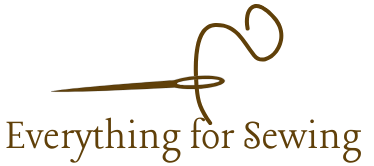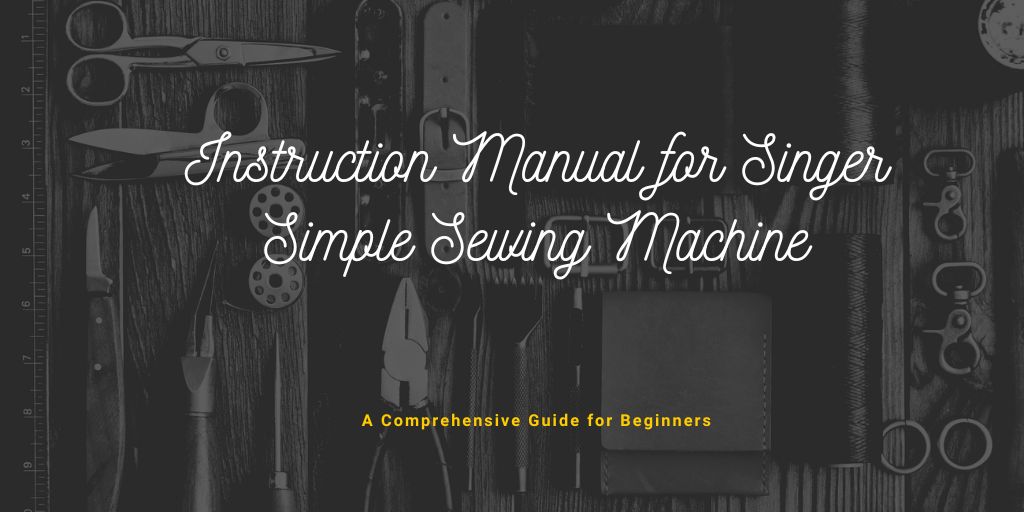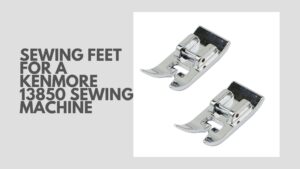For those looking to master their sewing skills, having access to the right resources is essential. An instruction manual for the Singer Simple sewing machine can provide valuable guidance for both beginners and experienced users.
This manual typically includes helpful information on setup, operation, troubleshooting, and maintenance.

Understanding how to use the Singer Simple sewing machine can significantly enhance the sewing experience. Many users find that the manual offers step-by-step instructions that make it easier to navigate various features and functions.
It serves as a reliable reference that can help enthusiasts tackle their projects with confidence and ease.
Whether one is sewing garments, crafts, or home decor, knowing how to properly operate the machine is crucial.
This blog post will explore the contents of the instruction manual, offering insights into how it can help users maximize their machine’s potential and enjoy the art of sewing even more.
Contents
Table of Contents
Getting to Know Your Singer Simple Sewing Machine
The Singer Simple sewing machine is designed for ease of use. It is ideal for beginners and experienced sewers alike.
Key features include:
- Automatic Stitch Selection: Choose from various stitches for different projects.
- 1-Step Buttonhole: Quickly create buttonholes with a single step.
- Free Arm: Ideal for sewing cuffs, collars, and hard-to-reach areas.
Familiarizing oneself with the machine will enhance the sewing experience. The instruction manual for the Singer Simple sewing machine is a helpful resource.
It contains detailed information on operating the machine, troubleshooting, and maintenance tips.
Important components include:
| Component | Function |
|---|---|
| Needle | Used for stitching fabric. |
| Presser Foot | Holds fabric in place during sewing. |
| Power Switch | Turns the machine on and off. |
| Stitch Selector | Allows the user to choose the desired stitch type. |
Understanding these parts is essential for successful sewing. Each function helps the user achieve accurate and professional results.
Regularly consulting the instruction manual will support effective use and care of the machine.
Setting Up Your Machine

Setting up the Singer Simple sewing machine involves careful steps to ensure it operates smoothly.
Proper preparation includes unpacking, connecting power, and ensuring all parts are correctly set up before starting to sew.
Unpacking and Inspection
When unpacking the Singer Simple, the first action is to remove it from the box carefully. Make sure to keep the packaging for potential returns.
Inspect the machine and components for any damage. The box should include the sewing machine, a foot pedal, power cord, needle, and various presser feet.
Check the instruction manual for the Singer Simple sewing machine for a complete list of included items. Ensure that all parts are present.
Look for the main body of the machine and inspect it for any scratches or defects that may affect its performance.
Power Supply and Foot Control
To connect the machine, it is important to plug it into a suitable power source.
Use the power cord that came with the machine. Locate the power port on the back or side of the machine and plug it in.
Next, connect the foot control, which allows for easy operation of the sewing machine.
The foot control usually plugs into the side of the machine. Once connected, the control should sit flat on the floor for easy access while sewing.
Before turning on the machine, ensure that the foot control is placed safely and comfortably.
Machine Connections
The Singer Simple needs to be set up correctly.
Start by ensuring the bobbin winder is in the correct position. This feature helps to fill the bobbin with thread before it is placed into the machine.
Then, check that the needle is properly installed.
Consult the instruction manual for the Singer Simple sewing machine for clear guidance on needle positioning.
Ensure the presser foot is also correctly attached.
Always follow the threading instructions, as outlined in the manual, to prevent any threading errors.
Proper setup is crucial for achieving the best sewing results.
Threading and Preparing to Sew

When using the Singer Simple sewing machine, proper preparation is key for successful sewing.
This section covers important steps like winding the bobbin, threading the top thread, inserting the bobbin, and adjusting thread tension. Each step ensures that the machine operates smoothly and efficiently.
Winding the Bobbin
To begin, winding the bobbin is essential for smooth operation.
First, place the spool of thread on its holder. Then, pull the thread through the tiny guide and onto the bobbin winder.
Next, push the bobbin winder to the right to engage it.
Start the machine to wind the thread onto the bobbin evenly. Stop the machine once the bobbin is full.
It’s important not to overfill, as this can cause issues later.
Finally, remove the bobbin carefully and cut the thread to prepare for the next step.
Threading the Top Thread
Threading the top thread involves a systematic approach.
First, raise the presser foot to release tension. Then, follow the threading path shown in the Singer Simple instruction manual for accurate placement.
Guide the thread from the spool through the upper thread guide and down to the take-up lever.
Pull the thread back down to the needle area and thread the needle. An automatic needle threader can ease this process.
Make sure the thread passes through the needle eye completely before proceeding.
Properly threading the top thread will enhance sewing efficiency and prevent tangles.
Inserting the Bobbin
Inserting the bobbin correctly is crucial for good sewing results.
Start by removing the bobbin case cover on the Singer Simple machine. Next, place the bobbin into the case, ensuring that the thread unwinds in the correct direction.
Pull the thread through the slot in the case and under the tension spring.
It is vital to make sure the thread is secured in the correct path to avoid jams. Replace the bobbin case cover securely.
This process is outlined in the instruction manual for the Singer Simple sewing machine, ensuring that no steps are missed.
Thread Tension Adjustment
Adjusting the thread tension is essential for achieving the desired stitch quality.
Typically, the Singer Simple sewing machine has a tension dial that allows for easy adjustments.
It is crucial to refer to the instruction manual for specific settings based on fabric type.
For lighter fabrics, lower tension may be needed. Conversely, heavier fabrics may require higher tension settings.
After making adjustments, it’s best to test the tension on a scrap piece of fabric.
Observing the stitch quality will indicate if further adjustments are necessary for optimal results.
Basic Sewing Techniques

Mastering basic sewing techniques is essential for anyone using the Singer Simple sewing machine.
Knowledge of how to start and end seams, perform various stitch types, and finish seams will enhance the sewing experience and improve results.
Starting and Ending Seams
Starting a seam properly ensures that the fabric stays in place.
Begin by placing the fabric under the presser foot and lowering it securely. To stabilize the seam, a few backstitches at the start can be helpful.
After sewing, end the seam with a few backstitches again to prevent unraveling. This technique is crucial for maintaining the integrity of the fabric.
The instruction manual for the Singer Simple showcases specific diagrams for these techniques, making it easier to understand the correct steps.
Straight Stitching
Straight stitching is likely the most common sewing technique. It involves sewing in a straight line, providing a strong and neat finish.
The Singer Simple sewing machine offers adjustable stitch length, allowing users to customize their stitches for different fabrics.
To create a straight stitch, choose the straight stitch setting on the machine. Ensure the fabric is aligned under the needle and guide it gently as it sews.
This technique is fundamental for seams, hems, and other sewing projects.
The use of proper thread tension contributes to achieving a smooth stitch.
Zigzag Stitching
Zigzag stitching serves multiple purposes, including finishing edges and creating decorative designs.
This stitch can prevent fraying by covering the raw edges of fabric.
To perform a zigzag stitch, set the Singer Simple to the zigzag stitch mode. Adjust the stitch width and length according to the needs of the project.
Zigzag stitches are versatile and can be used on stretch fabrics as they allow the fabric to move. This feature is especially helpful for seams in knit fabrics.
Seam Types and Finishing
Different seam types serve various purposes in sewing. The most common include plain seams, French seams, and flat-felled seams.
Plain seams are easy to create with the Singer Simple and are ideal for lightweight fabrics.
French seams encase raw edges, providing a clean finish, which is perfect for delicate fabrics.
Flat-felled seams offer extra strength, making them suitable for heavy or stress-prone areas.
To finish seams, users can employ techniques like pinking, serging, or using a zigzag stitch for durability.
The instruction manual provides clear guidelines on each seam type, enhancing the sewing experience.
Maintenance and Troubleshooting
Proper maintenance and timely troubleshooting are essential for keeping the Singer Simple sewing machine in good working order.
Regular care can prevent many common issues and prolong the machine’s life.
Cleaning and Oiling
Cleaning the sewing machine is vital for its performance. Dust, lint, and thread can accumulate and affect functionality.
Users should clean the machine after every few sewing sessions.
- Remove the throat plate: This allows access to the bobbin area.
- Use a small brush: Gently remove lint and debris.
- Wipe the exterior: A soft cloth can help keep the machine looking good.
Oiling is also necessary. Refer to the instruction manual for the specific oiling points.
A couple of drops of sewing machine oil can keep the moving parts lubricated and functioning smoothly.
Routine Machine Checks
Routine checks can spot potential issues before they become serious. Users should inspect the needle, threads, and bobbin regularly.
- Needle condition: A bent or dull needle can cause stitching problems. Change the needle after every few projects.
- Threading: Ensure the machine is threaded correctly to avoid jams.
- Tension settings: Check the tension regularly, especially when switching fabrics.
These small steps can greatly enhance the sewing experience and prevent malfunctions.
Common Issues and Fixes
Many common issues can arise while using the Singer Simple. Understanding how to address these can save time and frustration.
- Skipped stitches: This can happen due to a damaged needle or improper threading. Replacing the needle or re-threading the machine often resolves the issue.
- Thread bunching: If the thread is bunching under the fabric, it may mean the tension is too tight. Adjust the tension according to the fabric type.
- Machine not sewing: Ensure the machine is plugged in, and the presser foot is engaged. These basic checks can solve many problems.
Referring to the instruction manual for troubleshooting can provide helpful solutions.
When to Consult a Professional
Some problems require professional attention. Users should consider seeking help if they encounter persistent issues.
- Unusual noises: Grinding or clunking noises can indicate internal problems.
- Error messages: If the machine displays error codes, consulting the instruction manual may not suffice. A professional can provide insight into the issue.
- Electrical issues: Flickering lights or a dead machine often mean it’s time for a technician.
Regular maintenance can reduce the likelihood of needing professional help, but knowing when to seek assistance is crucial for keeping the sewing machine in good condition.
Accessories and Attachments

Having the right accessories and attachments can enhance the functionality of the Singer Simple sewing machine. Proper use can lead to better sewing results and a more enjoyable experience.
Available Accessories
The Singer Simple sewing machine comes with several essential accessories. Common items include a buttonhole foot, all-purpose foot, and zipper foot. Several additional accessories can be purchased separately to expand its use.
Some useful extras include:
- Walking Foot: Helps to evenly feed layers of fabric.
- Blind Hem Foot: Assists in creating invisible hems.
- Quilting Foot: Ideal for quilting projects.
These accessories enable more versatile sewing techniques. Users can refer to the instruction manual for Singer Simple sewing machine for detailed information on each accessory.
Changing Presser Feet
Changing presser feet on the Singer Simple is a straightforward process. First, users should make sure the machine is turned off. Then, the existing foot can be removed by pressing the lever at the back of the foot holder.
To attach a new presser foot:
- Align the foot to the holder.
- Lower the lever to secure it in place.
This simple process allows users to switch between different presser feet quickly. Familiarity with changing feet can enhance sewing capabilities.
Using Attachments for Specific Tasks
Using attachments can streamline specific sewing tasks. For instance, the buttonhole foot enables the creation of precise buttonholes with ease.
When using a hemmer foot, it helps to fold and sew hems with consistent results.
The specialty feet often have a guide or edge that helps to align fabric accurately. This improves precision in sewing tasks, allowing for better finishes.
Each attachment usually includes usage instructions in the instruction manual for Singer Simple sewing machine. Familiarizing oneself with these can prevent errors and optimize performance.
Advanced Features

The Singer Simple sewing machine offers several advanced features that enhance its functionality. These features include decorative stitches, options for sewing buttonholes, and the convenience of a free arm, making it suitable for a variety of sewing tasks.
Decorative Stitches
The Singer Simple comes with a selection of decorative stitches that allow for creative expression in projects. These stitches are perfect for adding flair to garments or home décor items.
Users can easily switch between stitches by selecting the corresponding dial setting. Common decorative stitches include zigzag, scallop, and various floral designs.
Using these stitches is straightforward, and they can be customized in length and width. This flexibility helps crafters achieve unique results tailored to their preferences.
Buttonholes and Button Sewing
Creating buttonholes is effortless with the Singer Simple’s 1-step buttonhole feature. This function allows users to make perfectly sized buttonholes without complicated adjustments.
To use this feature, the user simply places the button in the designated area and follows the machine’s instructions. The machine automatically senses the button size and adjusts accordingly.
Additionally, sewing on buttons is simplified with this machine. It offers a setting specifically for securely attaching buttons, making it suitable for anyone looking to mend or personalize clothing.
Using the Free Arm
The free arm feature is a standout functionality of the Singer Simple sewing machine. It allows for easier sewing of cylindrical objects like sleeves, pant legs, and cuffs.
By detaching the accessory compartment, users can access the free arm, making it simple to maneuver fabric. This feature enhances precision and control for detailed sewing tasks.
The design makes it easy to handle smaller areas that are hard to reach, thus improving the overall sewing experience. Whether altering garments or crafting new items, the free arm ensures professional-looking results.
Safety and Best Practices

Ensuring safety when using the Singer Simple sewing machine is crucial. Following specific guidelines helps prevent accidents and prolongs the machine’s life. Proper storage also plays a significant role in maintaining optimal performance.
Safe Operation Guidelines
When operating the Singer Simple sewing machine, it is essential to follow strict safety measures:
- Keep hands away from the needle: Always maintain a safe distance to avoid accidental injury.
- Switch off when not in use: Turn off the machine to prevent any unintended operation.
- Use only the recommended needles: Ensure that needles are compatible with the Singer brand to avoid damage.
- Wear safety glasses: This can protect eyes from flying debris, especially when troubleshooting or adjusting the machine.
Refer to the instruction manual for Singer Simple sewing machine for specific operational guidelines tailored to your model.
Machine Storage
Proper storage is key to extending the life of the sewing machine. Follow these recommendations:
- Store in a dry area: Moisture can lead to rust and damage electronic components.
- Use a cover: Protect the machine from dust and dirt when not in use.
- Keep away from direct sunlight: Prolonged exposure can affect the plastic parts and color.
- Avoid heavy objects: Do not place anything on top of the machine to prevent pressure damage.
Regularly check the storage area for cleanliness to ensure the Singer Simple sewing machine remains in top condition.
Warranty and Support

The warranty and support services for the Singer Simple sewing machine are essential for ensuring customer satisfaction and machine performance. Understanding the warranty details and how to access support can enhance the sewing experience.
Warranty Information
The Singer Simple sewing machine comes with a limited warranty designed to protect against defects in materials and workmanship. The warranty offers coverage for:
- 25 years on the sewing machine head
- 2 years on motors, light assemblies, wiring, switches, speed control, and electronic components
- 90 days for adjustments, belts, rings, bulbs, and attachments
To keep the warranty active, owners should register their machines online. Users can find additional details about their warranty terms in the instruction manual for the Singer Simple sewing machine. Familiarizing oneself with this information is vital for addressing issues that may arise during usage.
Customer Support
Singer offers robust customer support for owners of the Simple sewing machine.
Users can access help through various channels:
- Online FAQs: A comprehensive section helps to resolve common queries.
- Instruction Manuals: Available online, they provide detailed guidance for various models.
- Product Registration: This secures warranty access and updates about the machine.
For personalized assistance, customers can contact Singer’s support team via phone or email.
Utilizing these resources ensures that users can keep their machines running smoothly and address any concerns quickly.
For additional resources, visit the Support page for Singer sewing machines.




